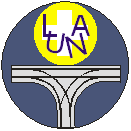

The HO Luna Tram Track and Surfacing System
1999-2001 first market studies
At the Nuremberg Toy Fair the situation for tram and streetcar modeling is problematical. For several years ideas for streetcar track have been shown - even handmade pieces were discussed. They all had a common problem: Typical streetcar track geometries are not the same as railroad trackage where the curvatures and switches are usually much larger. Also, the appearance of imbedded track is different from the normal ballasted track. Modeling imbedded streetcar trackage has always been time-consuming working with hydrocal, plaster, or other moldable materials.
Press
In the model streetcar press regular articles appeared describing streetcar modeling, but available easy to install streetcar type track was always missing. Editors and letter writers constantly asked for a long desired streetcar track system.
First experiences building a streetcar layout
For the company Navemo, Nahverkehrsmodelle AG in Zurich, which manufactures tram models, a layout was to be built. Radii of 200 and 250 mm were carefully made with flexible track for H0m (meter gauge). For the surface elements, among other things, cardboard strips with different surface textures was provided. This was an expedient method for saving some time and effort.
Idea
From much information, press reports and experience the development began which led to the Luna tram track and surfacing system.
|
2001-2002 development and basic principle: I wanted to have available streetcar track and geometries with small radii and different surface textures. Likewise it was my intention, to retool the trackage on the layout for the creation of port industries, and use other large areas for the streetcar system. Thus, the layout had to be redesigned to accomplish these ideas. Searches I anxiously looked at catalogs of the most well-known track manufacturers, bought various track material and carefully examined their profiles. I also measured switches and crossings under the magnifying glass and determined that they were much too large for streetcars and they would not be suitable to use on the layout. Books and cities In order to familiarize myself with streetcar track geometry, I poured through books, technical periodicals, and visited numerous cities in Switzerland and abroad with streetcars. I also had track plans of the city Zurich. Construction I decided to hold the radius R 250mm as the basic dimension of my streetcar track. The R 250mm with an elbow of 25° results in a leg length from approximately 105.6mm. Thus, arises the inside radius with R 203.2 mm and the parallel distance of 46.8mm. The track geometry was found and I now looked for a solution to make replaceable track baseplatess. After considerable thought It occurred to me that a simple fixed connection could be made with a tap and click! The next step was to make one baseplate to accomodate H0, and H0m/TT, and H0e (the two latter gauges are also widely used in Europe). The baseplate should remain constant, only the track gauge would have to change. This led to establishing a base plate width of 22mm. The search for a track profile began. I considered using grooved track rails. It became clear that grooved rails are much too complicated and the existing rail profiles are too low in the groove depth, which causes a problem with the flanges. By a coincidence the study led me to the Tillig catalog on the standard track. First I was surprised at the hollow rail section and then came the brilliant idea. When assembling, there were no problems with the flanges. Also, the track from above pleased me very well. When imbedded with surface elements the rails looked very much like streetcar track. Patent office I registered the model streetcar track system in the Swiss patent office. Manufacturer Finally, with the patent application in the bag, construction drafts and handmade samples arranged, I made the rounds and visited with Tillig at the 2002 Nuernberg Toy Fair In this company I found a competent manufacturing enterprise with track construction experience and the willingness to make a new track variety. My idea and the hollow rail section of Tillig led to the project development and to the final product: Luna Tram Track and Surfacing System. Project Since the first establishment of contact with the company Tillig, I drew the diagrams for the whole track assortment, developed the Logo and selected the name. Likewise I created the folder, the goods enclosing notes and the packing. Finally the prices were specified. Luna Tram Track Surface Element System The Tram Track is not available in individual parts. There are assortments, which are arranged from several elements, track baseplate, holding and surface baseplates. There is a selection of three surface textures: pavement, paving blocks or grass. The applicable straight baseplates are in the lengths 105.6 mm, 211.2 mm and 316.8 mm and the standard curved baseplates are available in 45° segments. The straight baseplate of 316.8 mm has a length of 3 straight 105.6 mm baseplates, and the curved baseplates are available in 1x25°, 1x15° and 1x5° segments. The switches and crossings are linked between the track profiles with the desired baseplates. The switch is a small wonder. Its fine mechanics make throwing the switch possible by its own mechanism or with a commercial switch machine by engaging a small hairspring in the desired position. Future The Luna track assortment offers possibilities for further expansion. The basic elements will remain compatible. Prototype streetcar track designs from various cities can be authentically copied. Model railroad and streetcar hobbyists will take the initiative to develop fascinating track plans and operation on their layouts. Manufacturing firm In the Tillig Company GmbH & CO kg in (D) 01855 Sebnitz, I found a competent manufacturing enterprise with track construction experience and the willingness to develop a new product line. Co-operation with the management, the technicians and the graphic department was the correct decision and led itself to the final product Luna Tram Track and Surfacing System. |